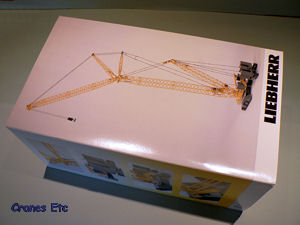 | | The box is the usual Liebherr picture box style - just it's huge. |  | 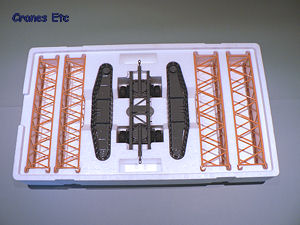 | | Bottom contains the tracks and large boom and jib pieces. | 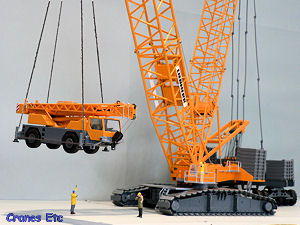 | | 'He ain't heavy, he's my brother...' | 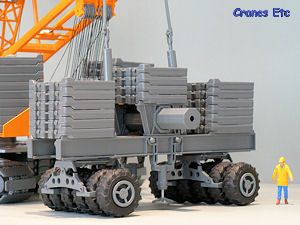 | | Ballast wagon loaded, but not fully. | 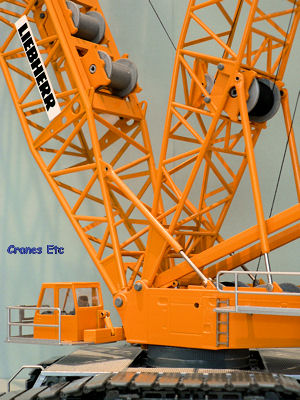 | | The model really impresses due to its massive proportions. | 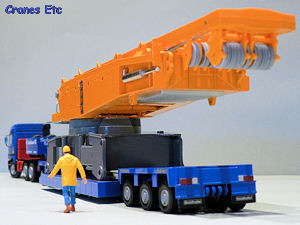 | | It looks impressive on a low loader although this one might be a bit small for the weight. | 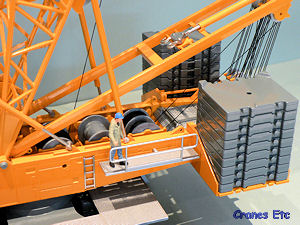 | | The walkway disguises the entry holes for the winch handles. The hydraulic hook is resting on the moving mast. | 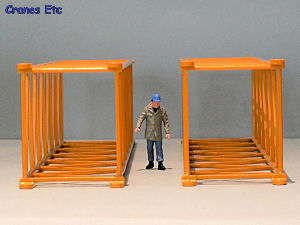 | | Booms are die cast and therefore dead straight. | 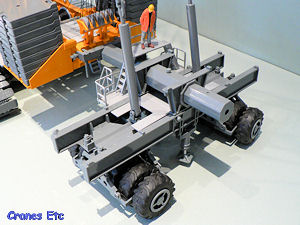 | | The ballast car unloaded. Note the position of the U-shaped walkway pieces. The manual does not describe these. | 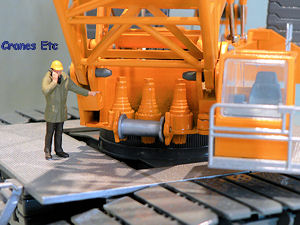 | | Close up showing the slewing drive motors and auxiliary winch drum. |
| This is a model of the giant Liebherr 1750 Crawler Crane. It is Conrad's second effort of a large crawler crane of this size and follows the Terex Demag CC8800 (see model 2735). It is also a sister machine to the Liebherr LG 1750 Truck Mounted Crane as many of the crane components are shared.
Packaging
The model box is very large and extremely heavy, and care is advised in handling it. It consists of a picture sleeve which wraps the three expanded polystyrene trays which contain the model, complete with a lid for the top tray. As expected, the box protects the model very well and there was no damage to the review model. There was a problem with one piece of the model however. The smaller 300t hook was missing the centre section pulleys but this was corrected by Conrad without fuss by the provision of a replacement hook.
A 26 page manual is included with model. This is printed in black and white and has the feel of being a slightly hastily produced document rather than a proper final release. It has photos of the box trays with parts annotated so they can be identified during the assembly process. Strangely the 300t hook block is missing from the photograph and not every piece is actually identified. The assembly instructions themselves are a series of staged photographs with the components at each stage identified. There are no written instructions at all which is presumably to avoid the need to provide translations. Although the pictorial stages are fine, the instructions fall short in the area of reeving the model. There is a lack of a clear description of which winch drums should control which function and where for example the hoist ropes should run through the derrick. There are reeving diagrams for the three sets of luffing gear which are barely clear enough in black and white, but nothing at all for reeving the hooks. It is a little disappointing that the model falls a bit short in this area as, with relatively little effort, a very good manual could have resulted.
With that said, the assembly of the model is actually a joy. Conrad's engineering is top notch and the model parts fit together very well indeed and without the need to adjust anything. As usual the reeving can try the patience and this model is no exception. Stringing up the hooks can lead to frustration as the string has a tendency to bounce off the pulleys so the best bet is to keep the string under tension at all times.
Detail
Each track frame is a large single piece consisting of the main structural frame which has some interesting casting detail. The drive motors are detailed and bear the Liebherr name finely cast in. The track pads appear to be the same as those used on the Terex Demag CC8800 model with the difference that the individual pads are pinned together rather than relying on the snap fit used on the early release of the Demag model. This is a much better, more robust design.
The main cross frame is a heavy piece and has the crane body permanently attached. There are four outriggers with jacks for lifting the crane body off a transport vehicle. The outrigger pads are plastic but they are not visible when the model is fully assembled. Also spanning the track frames is a pair of ballast plates which fit onto clips which attach onto the frames. The engineering of all pieces of the undercarriage is excellent and they fit together beautifully. The ballast plates carry three weights on each side. These are the usual high standard of casting including lifting lugs. On top of the weights, silver textured walkway plates rest to provide a platform for operator access and this part of the model is completed by a couple of ladders and handrails. A heavy toothed slewing ring sits on top of the undercarriage.
The crane body has a swing away cab which includes a walkway and handrails but does not have some of the smaller details such as wipers and mirrors. Inside, the cab has a representation of controls and screens. The crane body looks heavy and has essential detail within the casting representing panels and handles, and there are a couple of ladders. At the front, the three slewing motors look realistic, and they are complete with drive pinions, although there are no hydraulic lines modelled. Moving to the rear, the engine enclosure includes textured surfaces and grilles and a metal exhaust pipe. The grille detail also extends to the underside of the body. Heavy ballast trays hang off each side at the rear. In fact there is a pleasing absence of plastic on this part of the model with the main exception being the hoist drums and the bridles and pulleys on the luffing gear. The moving mast includes the hydraulic hook which the crane uses to assemble its own tracks.
The boom and jib sections are all fine examples of Conrad’s model engineering ability. Geometrically perfect, they fit together extremely well. They are joined together by the usual Conrad plastic pins which work just fine although small metal nuts and bolts would be more pleasing. At the crane body, spring loaded back stops prevent the booms from over luffing and these parts are all metal. All of the pulleys are plastic, and are free rolling. The suspension bars are also of the plastic interlocking variety favoured by Conrad. They are adequate but do not have the quality feel of metal pieces. The luffing bridles are plastic, presumably to keep the weight of these parts down so that the lines do not sag unduly. Another plastic part is the pulley holder on the main boom head and this would certainly have been better in metal like the luffing jib head, which is a heavy piece. Plastic Liebherr signboards are fixed to the boom and jib.
Two hooks are provided and these are impressive. Consisting of the same modular components, they strip down to separate pulley block and hook assemblies with only the pulleys and pins being plastic. The larger hook also has clip on ballast weights to keep the tension in the ropes. The last part of the model to describe is the separate ballast carrier which holds the majority of the 54 weights provided. Again this is all metal with the exception of the tyres, wheel hubs and jack pads.
The modelling of the steelwork is impressive with good detail. The slewing motors include drive pinions on this part of the model too. A full set of metal walkways and ladders is provided. A ‘stinger’ joins the ballast carrier to the crane and once again is perfectly engineered in metal.
Features
The model features working jacks to lift the crane body off of a transport vehicle. These rotate out from the cross frame and screw down to lift the crane.
The crawler tracks roll nicely and are mounted on a frame which is spring loaded at one end so that removing the tracks is straightforward.
The cab is a swinging type which tucks in at the front when in transport mode. It can also be tilted slightly to allow the operator comfort when the crane is lifting at height. The hydraulic ram which governs this has a cylinder jacket which is a couple of millimetres too long which restricts the tilt somewhat.
A working hydraulic hook is provided which is connected to the moving mast so that the crane can assemble its own tracks. This has a suitably stiff cylinder so that the hook can be posed at a variety of lengths and hold a load without the ram ‘bleeding’.
All three hoist drums in the crane body are spring loaded and resistant to slipping under load. They are operated using detachable winch handles which push through holes in the crane body and they have a slotted end so they can be driven using a powered screwdriver. The three hoist drums mounted in the boom and derrick sections are operated similarly so that all the functions of the real crane can be replicated. There is also a small auxiliary hoist drum at the front of the crane by the slewing motors.
The ballast carrier has screw jacks so that it too can be posed in transport mode. The stinger which attaches the ballast carrier to the crane is telescopic so that it can be positioned at different radii for very heavy lifts. The wheel assemblies on the ballast carrier rotate fully and there is a form of floating suspension also.
A major strength of the model is the ability to build it any configuration. Booms and jibs can be any length desired. A luffing jib can be mounted, or not, and the derrick is also an optional fixture. Similarly a variety of ballast weight configurations is available.
Quality
This model represents the best of Conrad quality. In model engineering terms it is very good indeed. Precisely made parts that fit together well, solid components and nothing too delicate are the hallmarks. Paintwork and graphics is all crisply done and plastic is kept to a reasonable minimum.
Not all details may be right and aficionados might query the use of track pads from the Terex Demag CC8800 model as being too wide for this crane, but they represent the 2m track pad option of the real machine. The trade off here is that the model is not as detailed as say, the Manitowoc 18000 from TWH, but in engineering quality, it is unsurpassed.
Price
As with other large crawler crane models it is hardly cheap and will be beyond the means of many collectors. However overall it is better value than the Terex Demag CC8800 and TWH's Manitowoc 18000.
Overall
It is hard to believe that any collector would be disappointed with this model. It is huge and superbly engineered. The display possibilities are the best of any large crane model as it can be broken down into transport size loads and this gives it a clear advantage in the features area. However it does not have the museum-piece level of detail of TWH's Manitowoc 18000 and in this sense it is slightly inferior.
As usual there are a few minor gripes. The manual should be better than the one provided with the review model. Some parts would give the model a higher quality feel if they were metal rather than plastic.
In summary this is an outstanding Conrad model.
Footnotes
The model first appeared at the Nuremberg Toy Fair in February 2005. A limited edition was produced of 500 models in Mammoet colours of red and black. An extension kit was made available separately consisting of one main boom section and one luffing jib section (part no 99907/01). The Taiwanese model maker YCC offered an upgrade to motorise the model. In 2007 the sister crane, the truck mounted LG1750, was announced by Conrad as model 2737. A version of the LR1750 in Felbermayr blue was shown at the 2009 Nuremberg Toy Fair. A version in the colours of Wagenborg was introduced in September 2012.
|
| |
| 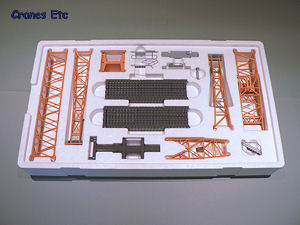 | | Top layer of the box holds weights and other pieces. | 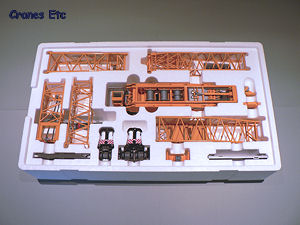 | | Middle section has the crane body. | 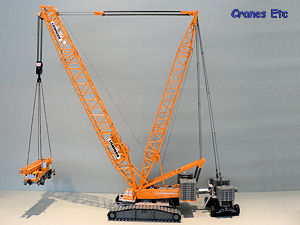 | | Rigged up with the ballast car. | 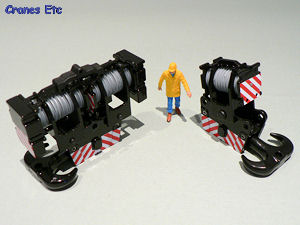 | | Two hooks come with the model. On the left is the 600t (with ballast weights on the cheeks) and on the right the 300t. | 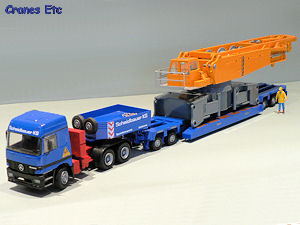 | | The model breaks down in to transportable pieces like the real thing. Here a piece is carried on a Goldhofer low loader. | 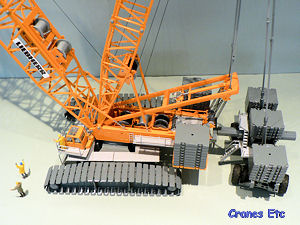 | | This is not a model to display on a thin glass shelf. | 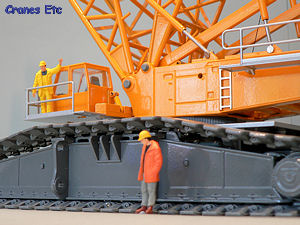 | | This is a super size model. Track frames have good detail. | 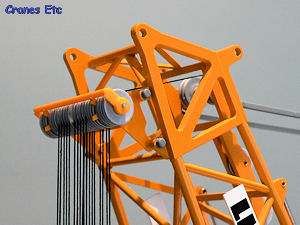 | | Top of the main boom. Pulleys are plastic as is the frame holding them. | 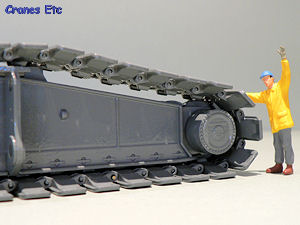 | | Track links are pinned together. | 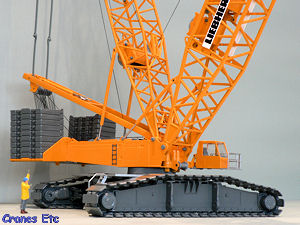 | | The size of the cab shows how big the crane is. | 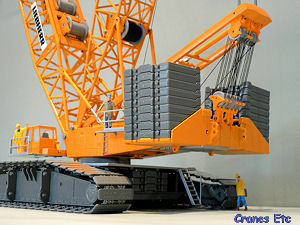 | | Loaded up with ballast. |
|

